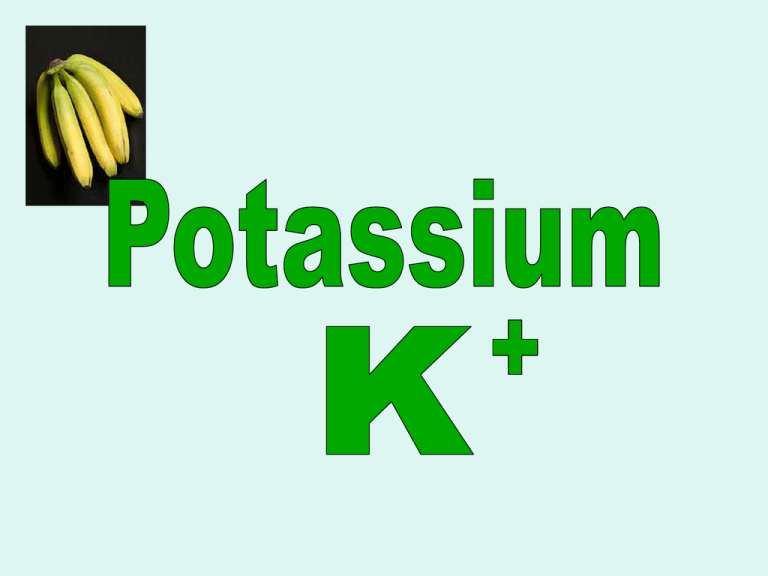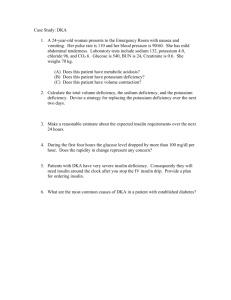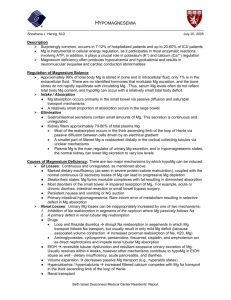Potassium
advertisement

K+ Atomic Number: 19 Electron Configuration: 1s2 2s2 2p6 3s2 3p6 4s1 Never found Free in Nature Reacts Violently with Water and Air KCl used as table salt substitute and to stop the Heart (lethal injection) Used in Fertilizer and Gun Powder and Glass manufacturing K+ History 1807- Sir Humphry Davy discoveres K 1871- Salkowski first describes K absorption & excretion 1874- Ringer shows that ions balance in natural salts 1894- Von Bunge describes relationships between Na & K 1926- Miller shows that dietary K is essential for normal life & Growth 1966- Woodbury postulates existence of electrogenic Na-K pump in cell membranes K+ General Functions Principle intracellular ion Intracellular Fluid Regulation: Osmotically active, involved in buffering, viscosity, CO2 transport (RBC), & Solublization of proteins present in the cell Membrane Effects: Influences membrane permeability, sodium pump action, muscular contraction & nerve impulse conduction K+ Facts Present in all plants and animals Alkali metal – Atomic Wt: 39.1 Present in the body as K+ – Common inorganic anions: • Cl, HPO4, bicarbonate, tartate, citrate – Organic anion: • Gluconate Body Content: 136g/70kg (3000-4000mmol) Relative Organ Concentrations: – RBC > muscle > brain > intestine > heart > pancreas > liver > kidney > lungs > uterus > skin > adrenal > skeleton > serum K+ Facts Skeletal Muscle’s mass and K+ concentration makes total body K+ track closely to lean body mass – ~2% total body K+ outside of cells, 98% intracellular – Intracellular concentration = 140 mmol/L – Extracellular concentration narrowly maintained @ 3.5-5.5 mmol/L Important Equation: E= -61.5 log ([K] ICF/[K]ECF) E= membrane potential difference in millivolts K+ Important for electrical properties of membranes – Hyper or hypo Kalemia can = failure to depolarize properly Symptoms of Deficiency & Excess are similar Weakness, lethargy, gastric hypomotility, cardiac arrhythmias Facts K+ Sources • Food Group K+ mg/100 kcal, Examples Leafy Greens 1,300, Spinach, lettuce, cabbage, kale Fruit of vines 1,200, Tomato, cukes, zucchini, eggplant, pumpkin Root Veggies 975, Carrots, radishes, turnip, rutabaga, onion Beans & peas 500, Kidney, green & soy beans; green & chick peas Tree fruits 430, Apple,orange,banana,apricot, grapes, strawberries Tubers 400, Potatoes, sweet potatoes, yams Milk & yogurt 350, Skim & whole milk or yogurts Meats 230, Beef, lamb, pork, poultry, fish, rabbit Nuts 110, Walnut, cashew, almonds, brazil, fibert Eggs & Cereal 90, All poultry eggs, wheat, rice, oats, rye Cheese & pecans 50, Edam, stilton, cheddar, pecans K+ Influences on Availability Decreased: - Boiling food in water w/ no added salt, addition of excess NaCl, meat diets, high processed food diets, diarrhea Increased: - Vegetarian diets, use of salt substitutes Typical US diets provide 50-80 mmol K+ per day Balance of intake/excretion less percise than Na & Cl Like Na, tolerance to high intakes w/ gradual increase K+ Absorption & Excretion Absorption – K+ well absorbed, >90% – Absorbed across entire intestinal tract – Active transport & passive diffusion and/or facilitation • Absorption enhanced by Na+, Mg2+, ionophore • Antagonized by Ca2+, cardiac glycosides & aldosterone (reverse secretion into gut) Extracellular Transport – Free in Blood as K+ K+ Absorption & Excretion Excretion – Half life in blood: ~0.39% of Plasma K+ excreted per minute at normal plasma levels (1.72 mg/100ml) • Freely filtered in glomerulus, reabsorbed in proximal tubules, & secreted in distal tubule via a process facilitated by aldosterone • Intestine & bile have little effect on body K+ content in healthy subjects: 5-10% daily excretion Hormones – Insulin directly stimulates K+ uptake by muscle and liver – Aldosterone increases renal excretion – Catecholamines: beta, hypo K+; alpha, hyper K+ K+ Symptoms Deficiency – Muscle weakness, cardiac arrhythmia, paralysis, bone fragility, sterility, adrenal hypertrophy, poor growth, weight loss, death Toxicity – Acute: tonoclonic convulsions, CNS paralysis, asphyxial convulsions, diarrhea, gastroenteritis, polydipsia, diuresis, dehydration, renal necrosis, fever, prostration, dilation of the heart, cardiac arrhythmia, lung collapse, respiratory failure – Chronic: cardiac & CNS depression, mental confusion, weakness, vomiting, numbness, tingling, flaccid paralysis of extremities K+ Cellular Transport Active Transport = Compartmentalization of K+ – – – – Na, K – ATPase pump H,K – ATPase pump Na-2Cl-K CoTransporters K conductance channels Insulin – Works to prevent hyperkalemia Catecholamines – Blunt increases in plasma K due to heavy exercise K+ Deficiency Causes Reduced K intake – Deficient diet or inadequate absorption Renal Losses – Diuretics – Osmotic diuresis (diabetes) – Excess mineral corticorticoid Intestinal Losses – Diarrhea – Laxative abuse Redistribution – Excess Catacholamines or insulin – Abnormal skeletal muscle calcium channels K+ Excess Causes Excessive Intake – Decreased renal loss • Acute renal failure or end stage renal disease • Mineralcorticoid deficiency • Potassium-sparing diuretics Redistribution – – – – Hemolysis, cellular necrosis, muscle injury Catecholamine antagonists Insulin deficiency Abnormal skeletal muscle calcium channels K+ Hypertension Increased K+ diets are hypotensive – Mechanisms not fully defined – Evidence based on epidemiology in nature • Rancho Bernado cohort = 40% ↓ in mortality after 12 yrs w/ ↑ F&V intake – DASH provided first intervention data • Whole food so no one nutrient could be tested in isolation • Complex effect: K+, Mg++, Ca++, & Citrate found in fruits that is converted to acid buffering bicarbonate in the body Blood Pressure appears to be the result of complex multi-nutrient interactions – Some effects observed acutely, others are chronic K+ Bones K+ now strongly implicated in bone health – Counteracts Na effects to increase Ca excretion – Typically consumed as citrate fruits that buffer acid load • Atkins diet = acidotic & calciuric • Increased kidney stone formation Marginal K+ Deficiency – No overt symptoms of hypokalemia – Insulin resistance occurs Hi Meat Lo Fruit & Vegetable ↑Sodium ↑Chloride ↓Potassium ↓HCO3+ ↑ H+ ↓ Renal Acidification Low grade Metabolic acidosis ↑Fluid Vasoconstriction ↓ Renal Na Excretion (gene/age) ↑Urinary ↑Central Ca++ ↓HCO3+ ↑ H+ ↓Urinary Citrate ↑Kidney Stones Blood Volume ↑Bone base titration ↑Osteoclastic activation ↓Osteoblastic activation Essential Hypertension Osteoporosis K+ Recommended Intake • DRI’s Published February 2004 Age 0-11m 1-3y 4-8y 9-13y 14-18y >18y Wt, Kg 4.5-8.9 11.0 16.0 25.0 50.0 70.0 400700 1,000 1,400 1,600 2,000 2,000 500700 3,000 3,800 4,500 4,700 4,700 Mg/d (1989) Mg/d (2004) K+ Fun Facts Lethal Injection Dosage: Insulin/K+ uptake – 100mEq KCl Insulin binds to recepter = hyperpolarization of cell membrane = K+ uptake Insulin also stimulates Na+ K+ Pump = cellular uptake of K+ Hyperkalemia Treatment: Chronic – Kayexalate (binding resin), Binds K+ in large intestine, 2-12 hrs Acute – treat with insulin, glucose, and Bicarb. = cellular K+ uptake






